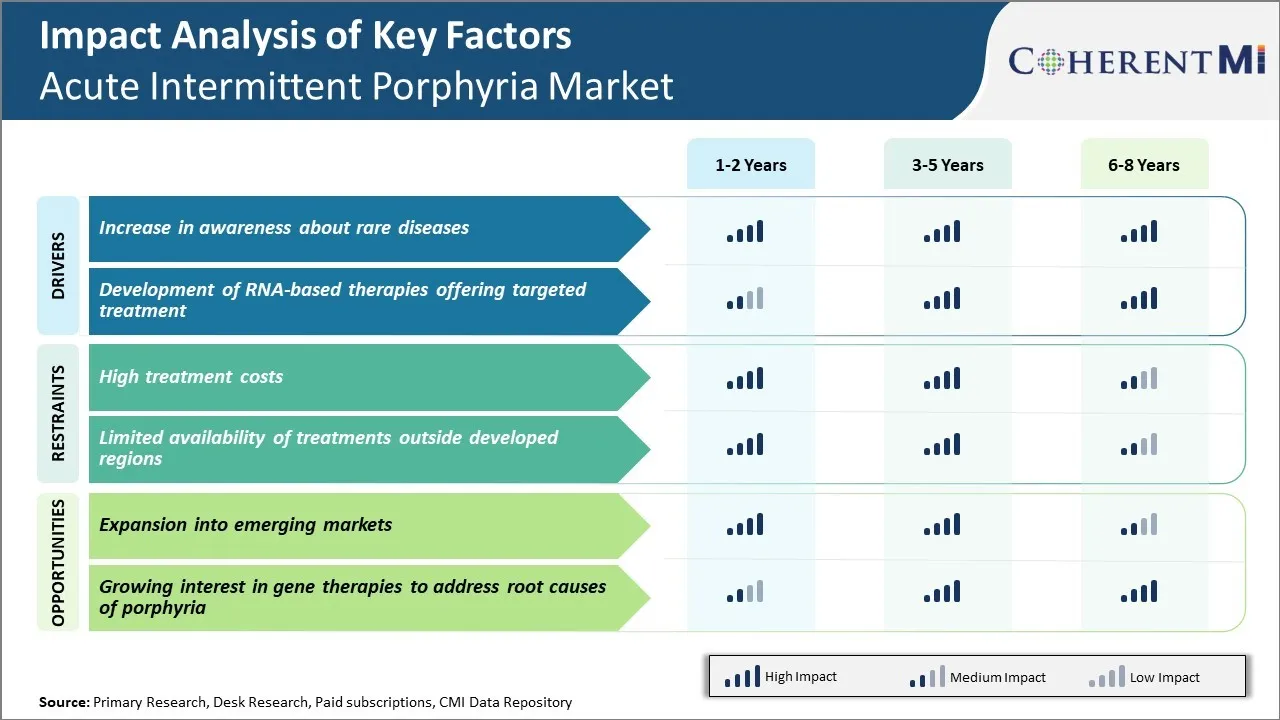Acute Intermittent Porphyria Market Trends
Market Driver - Increase in Awareness About Rare Diseases
With the advancement of technology and internet, awareness about rare diseases is rising exponentially. No longer are these diseases hidden due to lack of information. Doctors and researchers are also more vocal about these rare conditions. They publish research papers and give interviews to mainstream media. International rare disease day is marked every year with campaigns in various countries.
Patients who were earlier suffering in silence are now empowered to have a voice. Their questions related to causes, cures and management of the disease are quickly addressed. This leaves less scope for misinformation and unnecessary anxieties. As awareness rises, focus on rare diseases also increases in medical and nursing colleges. Newer doctors and healthcare staff learn about such conditions sooner in their career.
All these combined factors have significantly contributed to the growth of acute intermittent porphyria market. Early detection enables timely intervention techniques and symptom management approaches to be adopted. It prevents complications and deteriorating health conditions. Patients can get appropriate treatment instead of searching endlessly for proper diagnosis. Awareness removes the stigma around rare diseases and brings more funding as well as deeper research commitments from various stakeholders.
Market Driver - Development of RNA-based Therapies Offering Targeted Treatment
RNA-based therapies present a promising approach for genetic disorders like acute intermittent porphyria which has clear hereditary factors and genetic mutations involved in its pathology. Specifically, RNA interference (RNAi) techniques are being researched which can selectively block production of erring enzyme without harming other vital cell pathways. This unique strength of targeted action with minimal side effects makes RNAi an exciting area.
Several biotechs are conducting clinical trials of RNAi drugs for acute intermittent porphyria. If proven successful, they can achieve competitive edge over generic drug therapies given currently.
Besides RNAi, gene therapy as a new modality also offers hope. Correcting the genetic mutation at its root through gene replacement or editing can eliminate occurrence of attacks over long run. Early gene therapy studies show encouraging results and this field is progressing rapidly with each passing year. Advancements in vector engineering and targeting ability of vectors is further propelling such techniques.
Therefore, the breakthroughs happening in RNA-based platforms for specifically targeting genetic rare diseases like acute intermittent porphyria are major drivers. They provide solutions directly addressing underlying causes and not just symptoms. This differentiated approach fulfilling unmet needs will have strong implications on market growth in coming times.

Market Challenge - High reatment costs
One of the major challenges faced by the Acute Intermittent Porphyria market is the high treatment costs associated with managing the condition. AIP requires costly lifelong management to prevent attacks and potential complications. The primary treatments for AIP attacks include intravenous hemin injections which can cost thousands of dollars per injection.
In addition, long term care and monitoring is needed through frequent lab testing, specialist visits, diagnostic tests and drugs to help manage symptoms. All of these contribute to a heavy economic burden on patients and the overall healthcare system. The rarity of the condition means there are relatively few patients to help offset the high fixed research and development costs of new therapies.
Drug manufacturers are hesitant to invest in developing more affordable treatment options due to the small potential market size. Unless awareness and appropriate diagnosis improves significantly, high costs will continue restricting patient access to care and impacting the growth of the AIP market.
Market Opportunity - Expansion into Emerging Markets
One of the key opportunities for the Acute Intermittent Porphyria market is expansion into emerging markets. Currently, the market is dominated by developed countries in North America and Western Europe where awareness is higher and diagnostic capabilities are more advanced.
However, AIP has a global prevalence and remains underdiagnosed in many developing regions. There is immense potential to grow the market and improve patient outcomes by increasing diagnosis rates and access to existing therapies in emerging markets like Latin America, Asia Pacific and Middle Eastern countries. These countries represent rapidly growing healthcare sectors with rising income levels making treatment more affordable over time.
Companies operating in the AIP market could look at partnerships with local providers, patient advocacy groups and governments to launch awareness campaigns, education programs for physicians and subsidised treatment access models.
By expanding into new patient populations in emerging markets, companies can achieve significant revenue growth and economies of scale to help drive long term profitability and investments in developing next generation therapies.